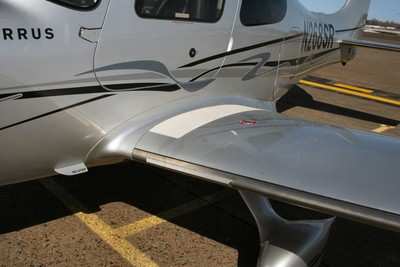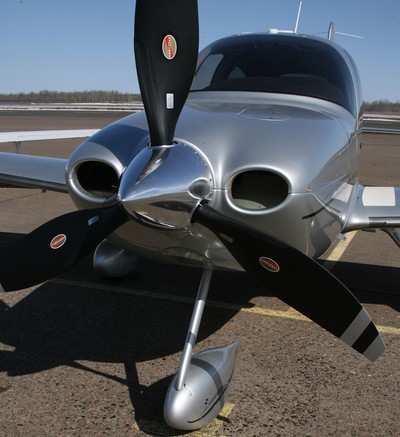Another Step In A Very Evolutionary Program
Flight Test Report and Analysis by ANN Editor-In-Chief Jim
Campbell
 While I've flown
virtually every type of piston Cirrus that Alan and Dale (the
irrepressible Klapmeier brothers) have built, the most notable
aspect of what they've accomplshed revolves around their
'utter failure' to leave well enough alone. While a number of
aircraft designs have seen few changes over the course of many
decades... it doesn't take long (weeks, maybe) before the Klapmeier
boys are fiddling around with their airplanes and looking to
improve the breed -- even after a major upgrade.
While I've flown
virtually every type of piston Cirrus that Alan and Dale (the
irrepressible Klapmeier brothers) have built, the most notable
aspect of what they've accomplshed revolves around their
'utter failure' to leave well enough alone. While a number of
aircraft designs have seen few changes over the course of many
decades... it doesn't take long (weeks, maybe) before the Klapmeier
boys are fiddling around with their airplanes and looking to
improve the breed -- even after a major upgrade.
Well... it's happened again. The latest iteration of the Cirrus,
this time with the moniker of "G3", is rolling off the flightline.
Several weeks ago, we were the first to try out the freshly
certified new hot-rod from the feverish design team that has
revolutionized an industry. The G3 is NOT an all-new airplane...
but rather a very positive evolutionary upgrade to a design that
didn't want for much to begin with. The design is also proof
positive that someone at Cirrus is reading their mail, as the
changes reflect the needs and desires of the fairly vociferous
Cirrus community, who (while they love their airplanes)
are not exactly bashful when it comes to speaking their
mind.
So... the G3 is more than a simple upgrade... it's the product
of hundreds of suggestions and requests from the Cirrus
community... leaving the latest bird easily the best Cirrus built
so far -- and some say, the best GA airplane, period.
The Cirrus team went through the bird from stem to stern in this
upgrade, with some big changes proving to be more than
skin-deep. An aggressive re-design of the primary wing structure
has resulted in a stronger and stiffer wing that allowed CD to
carve well over 50 pounds out of that assembly... and then use that
leeway to increase the bird's effective range.

The gear has been heavily modified to be a somewhat narrower and
taller construct that (to our experience) hasn't hurt a thing (in
terms of stability or control) and added some prop clearance, to
boot. The new gear gives the Cirrus about 2 inches more prop
breathing room and for those of us who have occasionally dropped
one of these critters in a little hard (especially on the nose),
this is a very good thing...
The gear used to be nearly 11 feet wide... and has been narrowed
to just over 8.5 feet. They did this with the same gear legs
they've used in the past, but mounted in a significantly more acute
angle. This change allowed the interior of the wing to be adapted
to a number of other modifications, most notably a larger TKS
deicing fluid tank, and produced a more efficient internal
structure. Internal fuel tankage jumped from 81 gallons to 92
gallons, as well. The 16% increase in range was a welcome and much
wanted upgrade from experienced Cirrus flyers, who tend to be a
wide-ranging lot. The new tanks, we're told, also incorporate fuel
indicating sensors that are expected to be even more accurate than
the units they replace.

A number of aerodynamic refinements have been incorporated...
quite a number, in fact, and many of them quite subtle. Several
fairings have been redesigned to offer less drag and improve other
aerodynamic efficiencies. A new wing root fairing, for instance,
has minimized spurious flow separation at the trailing edge of the
wing and enhanced both cruise and climb abilities. Gear fairings
have received exceptional attention to drag reduction and
simplification. The result is a far tighter and cleaner
installation that reduces the part count and slicks things up a
bit.
The wing's dihedral was hiked a full degree, thus creating
greater ground clearance, better yaw/roll harmonies and eliminating
the need for the rudder/aileron control interconnect that has been
a part of the Cirrus line since its inception. The enhanced
dihedral has definitely produced a more perceptible dihedral effect
without adversely affecting any aspect of the aircraft's already
laudable stability profile. This change produced the most tangible
difference inherent in the G3 line... a whole new "feel" in the
Cirrus' already reputable handling -- and I gotta tell you -- I
like it... a lot. Roll has a lighter and more responsive feel and
the manner in which it harmonizes with yaw is simply delightful.
While it is not remotely sensitive, the additional sense of
response, and the rate/pressures now inherent in roll actuation
make this bird even more pleasurable to maneuver -- and if you
gotta hankering to play "Bandits At 12 O'Clock High" for a few
minutes (and you know who you are...), you've gonna find yourself
grinning from ear to ear.

One of the other most noticeable changes can be seen along the
lengthy expanse of the wing's leading edge. The whole leading edge,
tip to root, is now fully encased in a TKS metallic anti-icing
fluid diffusion system that produces icing protection across a much
wider span (nearly four feet more) than the wings of old. With 30
minutes more TKS protection available (in normal mode, some 15
minutes more in "max" mode) thanks to the larger fluid tank, the
Cirrus is better equipped to deal with the perilous hazards of
icing encounters when some poor soul blunders where he or she
plainly should not be (and once again, you know who you are,
too).
The more comprehensive TKS installation raises
some interesting possibilities... as the additional
protection, larger fluid capacity and a number of other small
details leave one to question whether or not the Cirrus series may
soon be headed for known-icing certification. Most of the necessary
elements seem to be in place and with this new installation,
one sees few reasons why Cirrus (especially with the Turbo) may not
be within spitting distance of being able to certify this bird for
flight into (knowingly) more frigid conditions. We shall see.

Next: more details on the many changes that
make up a Cirrus G3 and why we think they're a great addition to
the line-up.
Note: Sorry for the delay in posting this
report, but efforts to cover Lakeland (and the ridiculous issues we
have to deal with, there) as well as accomplish a number of other
missions, taxed ANN to the max. Since ANN's Jim Campbell is the
sole press photographer on board the Zero-G 727 this week as
Professor Stephen Hawking gets to try out weightlessness, the rest
of this series may take a while to complete. Keep an eye out for
it... it'll be worth the wait.
 ANN's Daily Aero-Linx (04.13.24)
ANN's Daily Aero-Linx (04.13.24) ANN's Daily Aero-Term (04.13.24): Beyond Visual Line Of Sight (BVLOS)
ANN's Daily Aero-Term (04.13.24): Beyond Visual Line Of Sight (BVLOS) Airborne 04.09.24: SnF24!, Piper-DeltaHawk!, Fisher Update, Junkers
Airborne 04.09.24: SnF24!, Piper-DeltaHawk!, Fisher Update, Junkers Aero-News: Quote of the Day (04.14.24)
Aero-News: Quote of the Day (04.14.24) ANN's Daily Aero-Term (04.14.24): Maximum Authorized Altitude
ANN's Daily Aero-Term (04.14.24): Maximum Authorized Altitude







